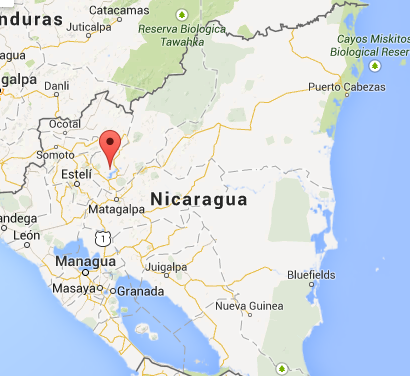Pueblo Nuevo, Nicaragua
![]()
![]()
![]()
![]()
![]()
![]()
![]()
![]()
![]() Click on Programs to learn more about their work in this community
Click on Programs to learn more about their work in this community
General Information

| Population* | 1,816 |
| Number of Houses | 269 |
| Avg # of people per home | 7 |
| Number & Percentage of Children |
0-5: 342 children, 17% 6-14: 214 children, 21% |
| Electricity | Yes, public electricity system |
| Location | Located 27 kms north of the city of Jinotega near the highway. It is approximately 1,003 meters above sea level. |
| Municipality | Jinotega |
| Department | Jinotega |
| Health Center | Yes, in good condition |
| Distance from compounds | Approx. 1.5 hours |
| Road conditions | Excellent |
* Population does not reflect how many patients will be seen on Medical
Brigades as many people from surrounding communities come seeking
Medical Brigades medical attention.
Top Three Needs Expressed
• Construction of a water system that supplies all of the households
• Construction of at least 215 latrines
• Training for youth that will decrease the risk of falling into common social health-risk behaviors (drug addiction, delinquency, pregnancy)
The community relies on one education center where 354 primary school students are taught in the morning section and 95 secondary school students are taught in the evening section. In addition, 184 students attend a secondary school farther away on Saturdays. Since the community is centrally located and is surrounded by many territories, this education center provides for many students from adjacent communities. This is the site where Medical Brigades will take place.
Twelve years ago, the mayor’s office constructed a water system that, at the time, supplied water for the whole community. Now, the population has quadrupled, so the water system is no longer sufficient to provide water for the while population. In general, homes only have water access for three hours a day every other day. Due to this limitation, the community has been using rivers, water fountains, and lakes for washing clothes and bathing.
This community has a health unit, which was constructed by the Nicaraguan government through the “Emergency Social Investment Fund” six years ago. The clinic has six consultation rooms, a waiting room, and a pharmacy. This clinic is staffed by four full-time physicians on weekdays. One of the main health difficulties in this area is medication shortages; the ill must often go to the city to find medications.
The primary source of income for this population is the cultivation of coffee. Some also produce farm goods such as cabbage, tomatoes, onions, potatos and others. Most of these crops are in the control of a small group of landowners and the rest of the community works for these land owners. Other income sources include fishing.
There are no other organizations working in this area.